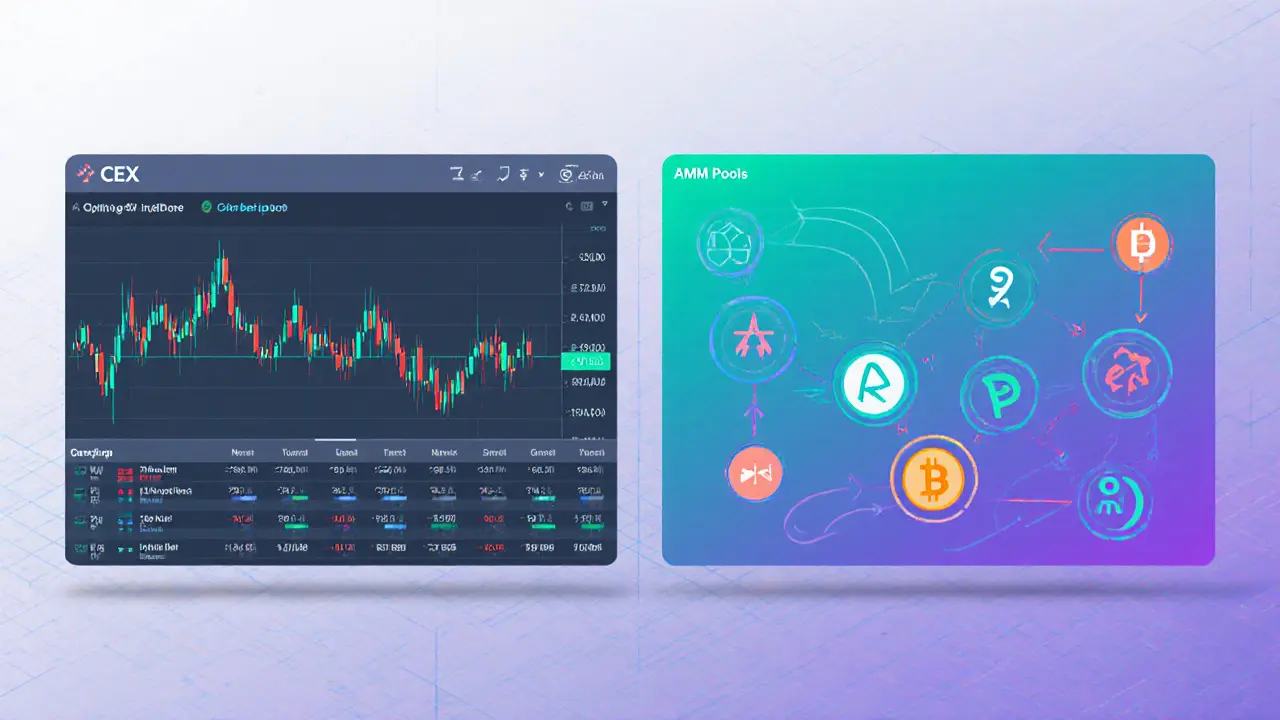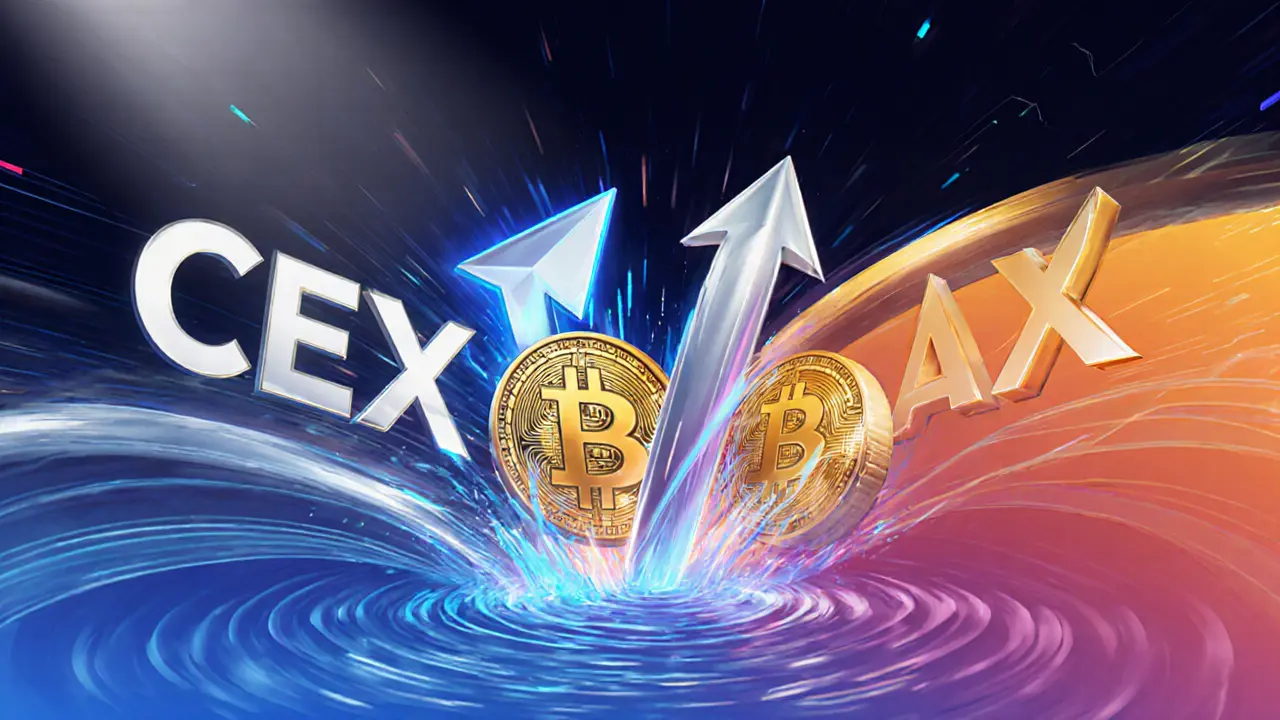Nov 17, 2024, Posted by: Ronan Caverly

DEX vs CEX Liquidity Comparison Tool
Deep liquidity with order-book matching engine
- High daily trading volume (billions of dollars)
- Professional market makers
- Instant settlement off-chain
- Low slippage for large orders
- Tight bid-ask spreads
Liquidity via AMM protocols and user pools
- Automated Market Makers (AMMs)
- User-provided liquidity pools
- On-chain transactions
- Higher slippage for large trades
- Reward-based incentive model
Liquidity Impact Results
Enter values and click calculate to see liquidity impact analysis.
Quick Take
- Centralized exchanges (CEXs) usually offer deeper liquidity because they aggregate billions of dollars in daily volume.
- Decentralized exchanges (DEXs) rely on automated market makers (AMMs) and user‑provided liquidity pools, which can be more volatile.
- Slippage is generally lower on CEXs for large orders; DEX traders often face higher price impact.
- Speed and settlement differ: CEX trades settle instantly off‑chain, while DEX trades depend on blockchain confirmation time.
- Incentive models diverge - CEXs reward market makers with rebates, DEXs pay liquidity providers through fee sharing and yield‑farming rewards.
What Liquidity means the ability to buy or sell an asset without moving the price too much actually means in crypto
When you hear the word crypto liquidity, think of how easily you can turn one token into another without watching the price jump. In traditional finance, high liquidity translates to tight bid‑ask spreads and low transaction costs. In crypto, the same principle applies, but the underlying mechanisms differ dramatically between centralized and decentralized platforms.
How Centralized Exchanges (CEXs) run traditional order‑book systems where a matching engine pairs buy and sell orders build deep liquidity pools
CEXs like Binance, Coinbase Pro, or Kraken handle daily trading volumes measured in tens of billions of dollars. Their order books aggregate orders from retail traders, institutional desks, and dedicated market‑making firms. The result is a "depth" of orders on both sides of the market, which tightens spreads and caps slippage even for multi‑million‑dollar trades.
Key reasons for this advantage:
- Centralized matching engine: trades are matched internally, bypassing the need for on‑chain confirmation.
- Professional market makers: firms receive fee rebates and can run sophisticated algorithms that continuously replenish order‑book depth.
- High user base: billions of dollars of daily turnover create a self‑reinforcing cycle-more liquidity attracts more traders, which in turn adds more liquidity.
Because the trades settle off‑chain, execution is near‑instant, allowing arbitrage bots to correct price deviations in milliseconds. This rapid feedback loop further stabilizes prices and improves overall liquidity.
How Decentralized Exchanges (DEXs) use automated market maker protocols where prices are set by the ratio of assets in a liquidity pool provide liquidity
Dex platforms such as Uniswap V3, SushiSwap, or Curve replace the order book with an Automated Market Maker (AMM) algorithm that determines price based on pool composition. Users become Liquidity Providers (LPs) people who lock two tokens into a pool and earn a share of the trading fees. The pool’s price adjusts automatically as trades shift the token ratio.
Advantages of this model include:
- No need for a counter‑party; trades execute against the pool itself.
- Transparency: all pool balances and transaction history are on‑chain and publicly viewable.
However, there are downsides:
- Liquidity is tied to the amount of capital LPs lock in; if many withdraw, depth evaporates.
- Large trades can cause significant price impact because the AMM curve moves sharply when a sizable portion of the pool is consumed.
- LPs face Impermanent Loss a temporary reduction in value when the relative price of the pooled tokens diverges, which can discourage long‑term provisioning.
Liquidity Metrics: Volume, Slippage, and Speed
When comparing the two models, three numbers matter most:
- Trading Volume: In July2025 Binance reported an average daily spot volume of roughly $20billion, while Uniswap V3’s daily volume hovered around $2billion-a ten‑fold gap.
- Slippage: On a CEX, a $100k market order for Bitcoin typically moves the price by less than 0.02%. On a DEX, the same order could incur 0.5%-1% slippage unless the pool is exceptionally deep.
- Execution Speed: CEXs confirm trades in milliseconds. DEXs are limited by blockchain block times; on Ethereum mainnet the average confirmation is about 12seconds, but during congestion it can stretch to a minute or more.
These metrics directly affect a trader's cost of entry and exit. Understanding them helps you decide when a CEX’s speed outweighs a DEX’s permissionless nature.

Incentive Structures: Rebates vs Yield Farming
CEXs usually offer fee rebates to high‑volume traders or designated market makers. For example, Binance’s “maker‑taker” model can reduce taker fees to 0.02% for VIP users, encouraging tight spreads.
DEXs, on the other hand, reward LPs through a combination of:
- Direct fee sharing (e.g., 0.3% of each swap goes to the pool).
- Additional Yield Farming programs that distribute native tokens as extra incentives-think of Uniswap’s UNI or SushiSwap’s SUSHI.
These rewards can boost APYs into double‑digit percentages, but they also attract speculative liquidity that may flee when rewards dwindle, causing sudden liquidity drops.
Risk Profile: Counterparty, Concentration, and Regulation
Counterparty risk: CEXs hold user assets in custodial wallets, exposing traders to exchange hacks or insolvency. DEXs eliminate this risk because assets never leave the user’s wallet; they are locked in smart contracts.
Liquidity concentration: In many DEX pools, a handful of large LPs own >50% of the capital. If one of them pulls out, the pool can lose half its depth overnight. CEXs spread risk across countless participants and professional market makers, making a single withdrawal less impactful.
Regulatory environment: CEXs must comply with KYC/AML, which can restrict access but also attract institutional capital that values compliance. DEXs often operate without identity checks, offering open access but facing uncertain regulatory futures that could affect long‑term liquidity.
When to Use a CEX and When to Use a DEX
Here’s a quick decision guide:
- Large orders or low slippage required: Prefer a CEX with deep order books.
- Need instant settlement for high‑frequency trading: CEXs win on speed.
- Desire full custody and no KYC: DEXs give you control of private keys.
- Looking to earn passive yield on idle tokens: Provide liquidity on a DEX and collect fees / farming rewards.
- Trading novel or niche tokens not listed on major CEXs: DEXs often list new assets first.
Many traders adopt a hybrid approach-execute large, time‑sensitive trades on a CEX, then move surplus assets to a DEX to earn yield.
Future Trends: Layer‑2 Scaling and Hybrid Liquidity Models
DEX liquidity is set to improve thanks to two major forces:
- Layer‑2 solutions: Optimistic and zk‑rollups on Ethereum cut transaction costs and confirmation times, making AMM pools more competitive with CEX speeds.
- Institutional DeFi participation: Companies are launching on‑chain market‑making desks that provide capital to DEX pools, narrowing the depth gap.
At the same time, CEXs are launching “custody‑light” products that let users retain private keys while still benefiting from the exchange’s order‑book depth. The line between the two worlds is blurring, and the best liquidity source will often be a blend of both.
Liquidity Assessment Checklist
| Aspect | Centralized Exchange (CEX) | Decentralized Exchange (DEX) |
|---|---|---|
| Liquidity Source | Professional market makers, institutional order flow | User‑provided pools, AMM algorithms |
| Typical Slippage (e.g., $100k trade) | 0.01%-0.03% | 0.3%-1% (depends on pool depth) |
| Execution Speed | Milliseconds (off‑chain matching) | 12s-60s (on‑chain confirmation) |
| Regulation | KYC/AML required, licensed jurisdictions | Generally permissionless, regulatory uncertainty |
| Risk Profile | Custodial risk, exchange hacks | Smart‑contract risk, impermanent loss, liquidity concentration |
| Incentives | Fee rebates, market‑maker rebates | Fee sharing, yield‑farming rewards |
Use this table to gauge which platform aligns with your risk tolerance, trade size, and speed needs.

Frequently Asked Questions
Why do DEXs experience higher slippage than CEXs?
DEX prices are set by the ratio of tokens in a liquidity pool. When a trade consumes a large share of that pool, the ratio shifts, moving the price along the AMM curve. Because the pool depth is often orders of magnitude smaller than a CEX order book, the price move translates into higher slippage.
Can I earn a decent yield by providing liquidity on a DEX?
Yes, especially on high‑traffic pairs that charge 0.3% fees per swap. Adding the extra token rewards from yield‑farming programs can push annualized returns into double‑digit percentages, though you must account for impermanent loss and potential token price volatility.
Do centralized exchanges have any advantage beyond liquidity?
Besides deeper liquidity, CEXs offer instant settlement, advanced order types (stop‑loss, trailing stops), and often tighter security features like insurance funds and regulated custodial services.
Is it safe to keep my assets on a DEX?
Your assets stay in your wallet until you approve a transaction. The main risks are smart‑contract bugs and the possibility of losing private keys. Using audited contracts and hardware wallets mitigates most of these concerns.
How do layer‑2 solutions affect DEX liquidity?
Layer‑2s cut transaction fees and confirmation times dramatically, encouraging more traders and LPs to participate. As a result, pool depths grow and slippage drops, making DEXs more competitive with CEXs on large trades.
Write a comment
Comments
Rochelle Gamauf
It is frankly astonishing how many novice traders still conflate the superficial allure of decentralized platforms with genuine market depth. The reality, as any seasoned professional will attest, is that centralized order books still dominate volume, rendering most DEX liquidity merely ornamental.
November 17, 2024 AT 10:29
Jerry Cassandro
When deciding between a CEX and a DEX, the first thing to consider is the type of asset you intend to move. Centralized exchanges boast deep order books, meaning you can execute large trades with minimal slippage, which is essential for institutional players. Their matching engines operate off‑chain, offering near‑instant settlement and a familiar UI that most traders are accustomed to. On the other hand, decentralized exchanges rely on automated market makers, which pool liquidity from individual providers and calculate prices algorithmically. This design eliminates the need for a middle‑man, granting you full custody of your tokens at all times. However, AMM pricing curves introduce higher slippage as trade size grows, particularly in low‑volume pools. If you value privacy and control, a DEX may be worth the extra cost in price impact. Conversely, if you prioritize speed and low transaction fees for large volumes, a CEX typically outperforms. Another factor is the reward structure: many DEXs distribute governance tokens to liquidity providers, creating an additional yield stream that can offset slippage. This incentive is absent in most traditional exchanges, where profits are derived solely from spreads and fees. Regulatory considerations also differ; centralized platforms must comply with KYC/AML, potentially limiting anonymity. Decentralized protocols operate without such gatekeepers, but they can be exposed to smart‑contract risk. You should also assess the security posture: CEXs are frequent targets of hacks, yet they often have insurance funds, while DEX vulnerabilities are buried in code that may go unaudited. In practice, many traders adopt a hybrid approach, routing small, frequent trades through DEXs for privacy while allocating bulk moves to CEXs for efficiency. Ultimately, run your own liquidity impact calculations, factor in gas costs, and align the choice with your risk tolerance and strategic goals.
November 24, 2024 AT 20:36
Parker DeWitt
Sure, that “expert” spiel sounds nice, but the real world always finds loopholes. 🤷♂️ Most DEX users end up paying way more in gas, and the token rewards are just a distraction from the core slippage problem. 🤦♀️
December 2, 2024 AT 06:42
Allie Smith
lol i get why u think cex are the only way, but honestly dapps are getting smarter every day
you cant ignore the vibe of holding your own keys, it feels way more free.
December 9, 2024 AT 16:48
Lexie Ludens
Enough with the polite charts! The entire crypto circus is a masquerade where DEXs pretend to be egalitarian while feeding the hungry beast of impermanent loss. Every time you add liquidity you are quietly signing away a slice of your future profits to anonymous pools that care not for your dreams. It’s a tragic comedy, a vortex that sucks the naïve into endless fee calculations while the true puppeteers sit back, sipping digital champagne. If you think the reward tokens absolve this shame, you’re living in a delusional fantasy.
December 17, 2024 AT 02:55
Aaron Casey
The scenario you describe aligns with the systemic risk metrics we observe in liquidity fragmentation. From a protocol‑level perspective, the AMM invariant introduces non‑linear price impact, which can be mitigated through multi‑pool routing and dynamic fee adjustments. Leveraging layer‑2 scaling solutions further reduces gas overhead, thereby addressing the cost asymmetry you highlighted. In essence, the architecture is evolving to reconcile incentive design with capital efficiency, a trend that savvy market participants should monitor.
December 24, 2024 AT 13:01
Leah Whitney
Hey folks, remember that the best strategy often blends both worlds. Start small on DEXs to get a feel for the flow, then scale up on a CEX when you need that deep liquidity punch. It’s all about finding the sweet spot that matches your comfort level and risk appetite.
December 31, 2024 AT 23:07
Lisa Stark
Indeed, the hybrid approach mirrors the philosophy of balance – neither extreme dominates, and the trader retains agency. By allocating capital across venues, you also diversify exposure to platform‑specific outages, which is a prudent risk management practice.
January 8, 2025 AT 09:14
Logan Cates
What they don’t tell you is that the biggest players are quietly funneling liquidity into hidden pools, manipulating price curves while the average user watches the surface. The whole “decentralized” narrative is just a smoke screen for centralized control.
January 15, 2025 AT 19:20
Shelley Arenson
🤔 interesting take! i think it’s good to stay skeptical, but also keep in mind that open‑source code lets anyone verify what’s really happening. 🌟
January 23, 2025 AT 05:26
Joel Poncz
i totally get the worry about hidden agendas, it’s hard to trust when info is scattered all over. but keep your eyes open and don’t let fear freeze you out of the market.
January 30, 2025 AT 15:33
Kris Roberts
the existential tension between transparency and opacity is a hallmark of modern finance. acknowledging our limited perception can guide us to build better tools that surface hidden dynamics without drowning in noise.
February 7, 2025 AT 01:39
lalit g
Let’s aim for cooperation rather than conflict. Both CEX and DEX ecosystems bring valuable services, and fostering dialogue between developers and regulators can lead to a more resilient and inclusive crypto landscape.
February 14, 2025 AT 11:45
Reid Priddy
While cooperation sounds nice, the reality is that regulatory capture will soon erode any genuine decentralization. The powers that be will co‑opt the open platforms, turning them into another tool for surveillance.
February 21, 2025 AT 21:51
Shamalama Dee
Remember, the choice isn’t binary. Educate yourself on the mechanics of each platform, practice with small amounts, and gradually build confidence. A well‑informed trader can navigate both realms safely.
March 1, 2025 AT 07:58
scott bell
yeah thats the key keep learning keep testing its all about experience not theory lets just dive in and see what works
March 8, 2025 AT 18:04
vincent gaytano
Oh sure, because trusting a codebase written by anonymous strangers is completely risk‑free. Nothing says “secure” like a smart contract that could be rewritten overnight by a rogue developer.
March 16, 2025 AT 04:10
Dyeshanae Navarro
security is a journey not a destination. we learn, fix bugs, and get better each time.
March 23, 2025 AT 14:17
Matt Potter
Don’t let the noise stop you – push forward, seize the market, and let the profits speak louder than any doubt.
March 31, 2025 AT 00:23
Marli Ramos
totally agree lets goooo 🚀

Author
Ronan Caverly
I'm a blockchain analyst and market strategist bridging crypto and equities. I research protocols, decode tokenomics, and track exchange flows to spot risk and opportunity. I invest privately and advise fintech teams on go-to-market and compliance-aware growth. I also publish weekly insights to help retail and funds navigate digital asset cycles.